

Putting
on the Pressure - for Three Decades

Eilige Drucksache - seit drei
Jahrzehnten
 |
Thirty years of the 911 Turbo
Particularly
one of the cars on display at the Paris Motor Show back in 1974 aroused huge
attention right from the start through its exceptional looks and visible
features:
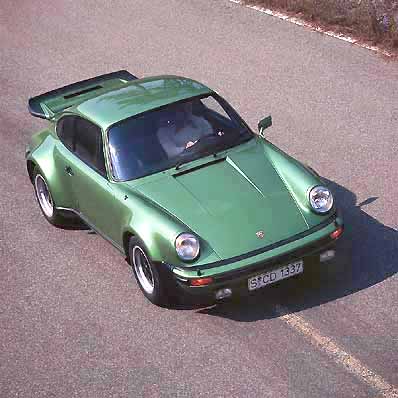 The biggest eye-catcher was a large rear
wing on the engine lid, perforated by ventilation slots and framed by a thick
rubber "lip". And what lurked beneath this big rear spoiler made even the
most experienced Porsche driver gasp for breath: A three-litre six-cylinder
horizontally-opposed power unit with a turbocharger, 260 bhp maximum output,
a top speed of 250 km/h or 155 mph, and the bite of thoroughbred racing machine.
And that, basically, was what it was: The Porsche 911 Turbo was not only
the fastest road-going German sports car, but also the forerunner to a genuine
turbo boom. And, most definitely, it was also a bold step into the future.
While turbocharged engines were no longer that unusual in motorsport, only
one manufacturer had attempted to introduce such an engine in a road-going
car so far - and had suffered big problems in the process. The reason, quite
simply, was that the high power provided by the turbocharger generally meant
a significant reduction in engine life, making the engine very sensitive
and making the car challenging - if not to say, difficult - to drive. In
a nutshell, therefore, the turbo engine was regarded as hard - or even impossible
- to handle. The biggest eye-catcher was a large rear
wing on the engine lid, perforated by ventilation slots and framed by a thick
rubber "lip". And what lurked beneath this big rear spoiler made even the
most experienced Porsche driver gasp for breath: A three-litre six-cylinder
horizontally-opposed power unit with a turbocharger, 260 bhp maximum output,
a top speed of 250 km/h or 155 mph, and the bite of thoroughbred racing machine.
And that, basically, was what it was: The Porsche 911 Turbo was not only
the fastest road-going German sports car, but also the forerunner to a genuine
turbo boom. And, most definitely, it was also a bold step into the future.
While turbocharged engines were no longer that unusual in motorsport, only
one manufacturer had attempted to introduce such an engine in a road-going
car so far - and had suffered big problems in the process. The reason, quite
simply, was that the high power provided by the turbocharger generally meant
a significant reduction in engine life, making the engine very sensitive
and making the car challenging - if not to say, difficult - to drive. In
a nutshell, therefore, the turbo engine was regarded as hard - or even impossible
- to handle. |
The basic concept:
a racing car for the road
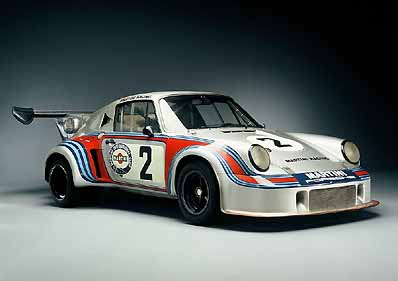 Porsche's engineers, however, proved
superior in their know-how and practical implementation of the concept: The
original plan was to build a small series of Gran Turismo sports cars derived
from motor racing and now legal for road use. Back then the GT regulations
called for a production volume of 400 units. But since Porsche saw no way
to sell that many cars to racing drivers, the Company decided to make the
competition model street-legal, making only a few concessions to motoring
comfort. The turbocharged engine was of course the heart of the new car from
the very beginning: First, Porsche had already gained experience with this
technology in the 12-cylinder 917/10 and 917/30 race cars developing maximum
output of up to 1100 bhp. Second, the general feeling was that the 911 power
unit originally introduced in 1983 with 130 bhp no longer offered adequate
potential for a further increase in power and victory on the race track,
without enjoying the benefits of turbocharging. Accordingly, while the
normal-aspiration power unit of the RSR 3.0 upgraded for motorsport in 1974
developed maximum output of 330 bhp, the 911 Carrera RSR 2.1 raced in the
same year developed 500 bhp with the help of a turbocharger. Porsche's engineers, however, proved
superior in their know-how and practical implementation of the concept: The
original plan was to build a small series of Gran Turismo sports cars derived
from motor racing and now legal for road use. Back then the GT regulations
called for a production volume of 400 units. But since Porsche saw no way
to sell that many cars to racing drivers, the Company decided to make the
competition model street-legal, making only a few concessions to motoring
comfort. The turbocharged engine was of course the heart of the new car from
the very beginning: First, Porsche had already gained experience with this
technology in the 12-cylinder 917/10 and 917/30 race cars developing maximum
output of up to 1100 bhp. Second, the general feeling was that the 911 power
unit originally introduced in 1983 with 130 bhp no longer offered adequate
potential for a further increase in power and victory on the race track,
without enjoying the benefits of turbocharging. Accordingly, while the
normal-aspiration power unit of the RSR 3.0 upgraded for motorsport in 1974
developed maximum output of 330 bhp, the 911 Carrera RSR 2.1 raced in the
same year developed 500 bhp with the help of a turbocharger.
With the minimum weight for GT racing cars being increased in spring 1974,
Porsche saw the opportunity to build not a racing car in disguise, but rather
a luxury high-performance sports car as the foundation for the racing version.
So from March 1974 to the introduction of the new model in October of the
same year, the new concept was converted into reality for the flagship within
the Porsche range (fully homologated for the road, of course). To overcome
the disadvantages of the turbocharged power unit such as inadequate power
and acceleration at low engine speeds, Porsche introduced a concept of
turbocharger pressure control by means of an exhaust gas by-pass valve previously
only seen in motorsport. Benefitting from this sophisticated management concept,
Porsche's engineers were able to suitably modify the dimensions of the
turbocharger to build up more pressure at low engine speeds and thus develop
extra torque in the process. To keep this more than ample power under control,
Porsche's engineers used their extensive experience in motorsport also for
the brakes, fitting the car with inner-vented disc brakes complete with aluminium
brake callipers originally featured in the Porsche 917 racing car. Instead
of 400 cars, the objective Porsche now set itself was to build 1,000 units
of the 911 Turbo 3.0. But this forecast soon proved completely inadequate,
production of the 911 Turbo 3.0 featuring amenities widely recognised as
luxurious at the time such as electric window lifts and a stereo cassette
radio amounting to 2,876 units by 1977. |
1977: the Porsche
Turbo breaks the magic mark of 300 bhp
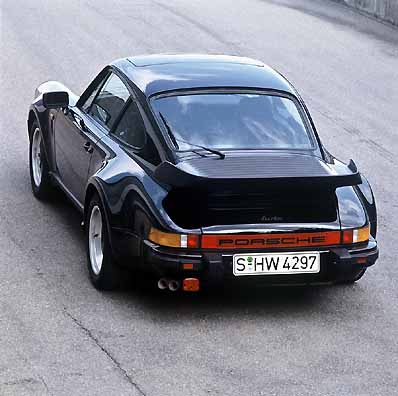 With deliveries of the Porsche 911 Turbo
starting in spring 1975, nobody really believed that a car of this calibre
might ever require even more power. But they were wrong! In 1977 Porsche
introduced the 911 Turbo 3.3 powered by an even larger engine now, with the
help of an intercooler, developing that magic figure of 300 bhp. Code-named
the 930 model series, this sports car remains a legend to this day. Porsche's
next major breakthrough came in 1982, in a process of ongoing development:
Thoroughly optimising the fuel supply system, Porsche's engineers were able
to significantly reduce fuel consumption while maintaining the same high
level of power: Instead of 20 litres in city traffic (14.1 mpg Imp), fuel
consumption was now just 15.5 litres (18.2 mpg Imp), the corresponding
improvement at a steady speed of 120 km/h or 75 mph being 11.8 litres (23.9
mpg Imp) instead of 15.3 litres (18.5 mpg Imp) so far. In 1987 the Coupé
version was joined by a Targa and a Convertible. At an initial price of DM
152,000, customers received one of the fastest open cars in the world coming
as a no-cost option with electrical operation of the roof. Just one year
later, five-speed transmission replaced the former four-speed gearbox, close
gear increments serving to keep turbocharger pressure even more consistent
while shifting gears and improving acceleration from a standstill to 100
km/h by 0.2 seconds to 5.2 seconds. By 1989 the Porsche Turbo became the
fastest best seller in the German market, with sales amounting to almost
21,000 units hardly modified in their exterior design and appearance. With deliveries of the Porsche 911 Turbo
starting in spring 1975, nobody really believed that a car of this calibre
might ever require even more power. But they were wrong! In 1977 Porsche
introduced the 911 Turbo 3.3 powered by an even larger engine now, with the
help of an intercooler, developing that magic figure of 300 bhp. Code-named
the 930 model series, this sports car remains a legend to this day. Porsche's
next major breakthrough came in 1982, in a process of ongoing development:
Thoroughly optimising the fuel supply system, Porsche's engineers were able
to significantly reduce fuel consumption while maintaining the same high
level of power: Instead of 20 litres in city traffic (14.1 mpg Imp), fuel
consumption was now just 15.5 litres (18.2 mpg Imp), the corresponding
improvement at a steady speed of 120 km/h or 75 mph being 11.8 litres (23.9
mpg Imp) instead of 15.3 litres (18.5 mpg Imp) so far. In 1987 the Coupé
version was joined by a Targa and a Convertible. At an initial price of DM
152,000, customers received one of the fastest open cars in the world coming
as a no-cost option with electrical operation of the roof. Just one year
later, five-speed transmission replaced the former four-speed gearbox, close
gear increments serving to keep turbocharger pressure even more consistent
while shifting gears and improving acceleration from a standstill to 100
km/h by 0.2 seconds to 5.2 seconds. By 1989 the Porsche Turbo became the
fastest best seller in the German market, with sales amounting to almost
21,000 units hardly modified in their exterior design and appearance.
Following a break in production of two years, Porsche presented a new 911
Turbo in 1991: The 3.3-litre power unit now developed maximum output of 320
bhp, the new car being based on the 911 model series code-named the 964 within
the Company and by the connoisseur. When Porsche modified this model in 1993,
power was increased in the process, the 911 Turbo 3.6 now developing maximum
output of 360 bhp. |
1995: enhanced
fuel economy setting a new standard in the sports car segment
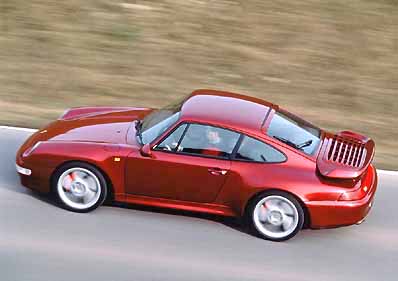 Entering the 1994 model year, the 964
model series was replaced by the 993. But the new Turbo in the 911 model
range took a bit more time coming, the next Turbo generation entering the
market in 1995 and immediately setting a new standard once again: The power
unit of this 911 Turbo based on the air-cooled 3.6-litre engine of the 911
Carrera and featuring two turbochargers developed maximum output of 408 bhp
at 5750 rpm. Acceleration from 0 - 100 km/h came in 4.3 seconds, top speed
was 293 km/h or 182 mph. The exhaust system featured two metal-based catalytic
converters and four oxygen sensors. A significant contribution to superior
environmental protection typical of Porsche to this very day was made by
the on-board diagnosis system II (OBD II). Fitted worldwide in all 911 Turbos,
this sophisticated system permanently supervises all components relevant
to exhaust emissions, immediately detecting any defects and activating a
warning light in the cockpit. As a result, the 993-series Turbo was lauded
the world over for its particularly clean exhaust emissions. Entering the 1994 model year, the 964
model series was replaced by the 993. But the new Turbo in the 911 model
range took a bit more time coming, the next Turbo generation entering the
market in 1995 and immediately setting a new standard once again: The power
unit of this 911 Turbo based on the air-cooled 3.6-litre engine of the 911
Carrera and featuring two turbochargers developed maximum output of 408 bhp
at 5750 rpm. Acceleration from 0 - 100 km/h came in 4.3 seconds, top speed
was 293 km/h or 182 mph. The exhaust system featured two metal-based catalytic
converters and four oxygen sensors. A significant contribution to superior
environmental protection typical of Porsche to this very day was made by
the on-board diagnosis system II (OBD II). Fitted worldwide in all 911 Turbos,
this sophisticated system permanently supervises all components relevant
to exhaust emissions, immediately detecting any defects and activating a
warning light in the cockpit. As a result, the 993-series Turbo was lauded
the world over for its particularly clean exhaust emissions.
Yet another outstanding innovation was all-wheel drive carried over from
the 911 Carrera 4 in the interest of optimised driving behaviour, traction
and stability on the road. In the same process Porsche's engineers re-designed
both the front and rear end, adapting the side-sills to the wider wheel arches.
The single-piece front end now came with even larger air scoops, yet another
new development being the rear spoiler fixed in position. Air resistance
was optimised by the air flow lip at the bottom of the front air dam and
by improved flow conditions throughout the front end of the car as a whole,
lift forces being reduced in the process to virtually zero both front and
rear. Production of this version of the 911 Turbo amounted to 6,314 units. |
Entering the
year 2000: more power, greater economy
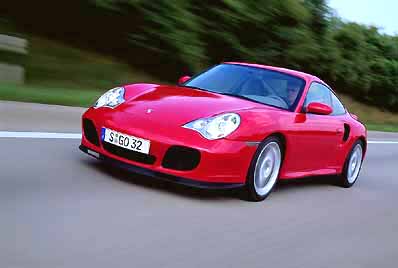 The current Porsche 911 Turbo (the 996
model series) - again featuring four-wheel drive and bi-turbo technology
- is not only one of the fastest and most powerful sports cars in the world,
but also won the title of the "World's Cleanest Car" when introduced in February
2000. The abbreviation "LEV" used above all in the USA stands for "Low Emission
Vehicle" - and Porsche's extra-clean Turbo fulfils this strict emission standard
in the same way as it complies with the EU 3 or D4 standards. Fuel consumption,
in turn, has been reduced once again from the former model already widely
lauded for its fuel economy by another 18 per cent to 12.9 litres/100 km
(21.9 mpg Imp) in the composite EU cycle. And exhaust emissions are down
by an equally impressive 13 per cent. Improvements of this kind are made
possible by four-valve technology, water cooling and, in particular, VarioCam
Plus serving to adjust the camshafts and vary valve lift as required. Indeed,
it is fair to say that VarioCam Plus combines two engine concepts in one,
serving to reduce fuel consumption and exhaust emissions and improve motoring
refinement all in one. The current Porsche 911 Turbo (the 996
model series) - again featuring four-wheel drive and bi-turbo technology
- is not only one of the fastest and most powerful sports cars in the world,
but also won the title of the "World's Cleanest Car" when introduced in February
2000. The abbreviation "LEV" used above all in the USA stands for "Low Emission
Vehicle" - and Porsche's extra-clean Turbo fulfils this strict emission standard
in the same way as it complies with the EU 3 or D4 standards. Fuel consumption,
in turn, has been reduced once again from the former model already widely
lauded for its fuel economy by another 18 per cent to 12.9 litres/100 km
(21.9 mpg Imp) in the composite EU cycle. And exhaust emissions are down
by an equally impressive 13 per cent. Improvements of this kind are made
possible by four-valve technology, water cooling and, in particular, VarioCam
Plus serving to adjust the camshafts and vary valve lift as required. Indeed,
it is fair to say that VarioCam Plus combines two engine concepts in one,
serving to reduce fuel consumption and exhaust emissions and improve motoring
refinement all in one.
The catalytic converters are right behind the turbochargers, the first, smaller
catalyst taking effect very soon after the engine is started cold. The main
catalyst, in turn, is designed for optimum conversion of exhaust emissions
with the engine at normal operating temperature. On-board diagnosis (OBD)
checks, as on the 993-series Turbo, whether all components and functions
relevant to exhaust emissions are working properly. OBD immediately detects
even the slightest deviation from target figures by consistently monitoring
exhaust emissions with electronic accuracy, any defects being reported by
a display in the cockpit. |
Ceramic brake
discs available as an option
The current Turbo model stands out clearly from the other models in the 911
Carrera (996-series) range through its striking air scoops at the front.
The rear end of the car, in turn, is characterised by a newly designed wing
as well as the air intakes and outlets for the intercooler. The car's impressive
specifications and performance data are 420 bhp maximum output, acceleration
from 0 - 100 km/h in 4.2 seconds, and a top speed of 305 km/h or 189 mph.
And since autumn 2000, the Turbo has also been available with composite ceramic
brake discs. Despite this ongoing process of development, the 911 Turbo has
retained its character throughout three decades: Outstanding performance,
supreme acceleration and superior luxury (five-speed automatic transmission,
Tiptronic S, leather upholstery) as well as impressive quality and lasting
value have enabled this dynamic sports car to become a genuine classic in
the course of the last thirty years, a car which already today holds a unique
position in the world of motoring.
READER COMMENTS

| Porsche Press Information,
August 2004 |
BACK TO TOP |